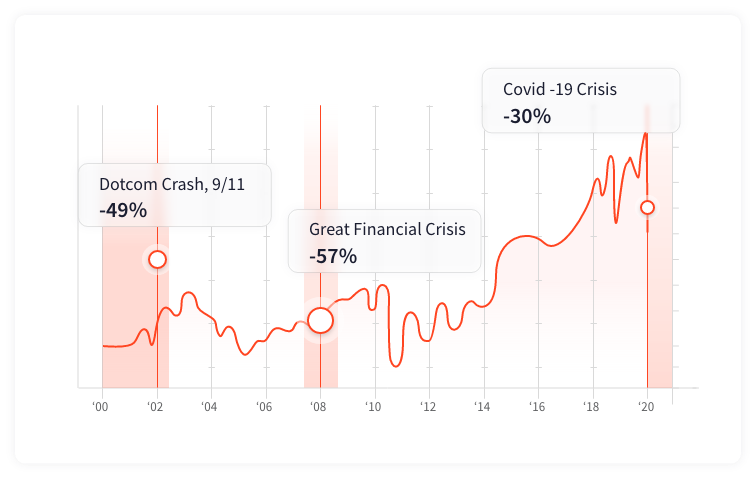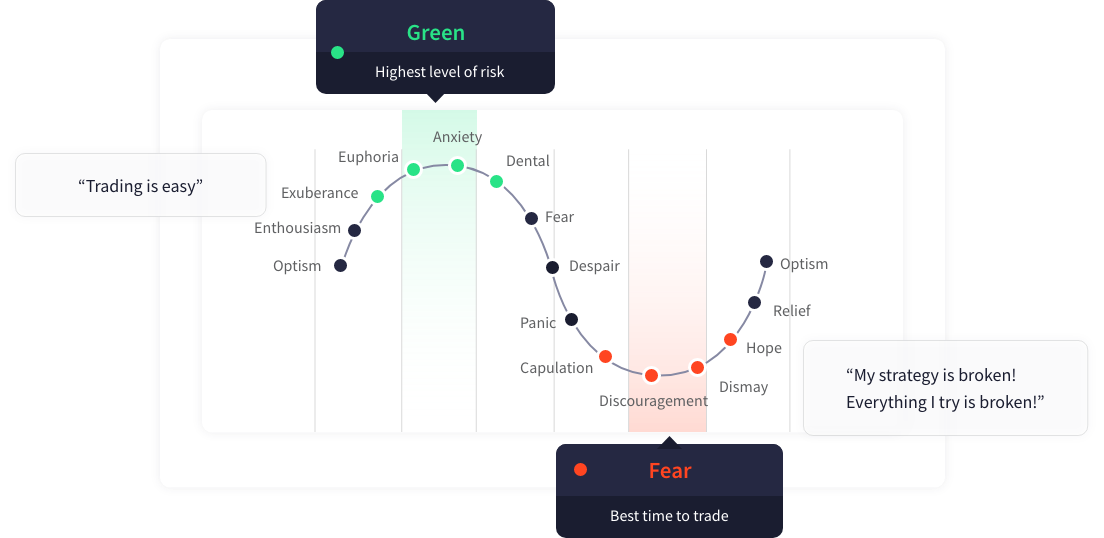What is volatility? What does a volatility look like?
Experienced traders are well aware of when volatility may increase in interconnected trading markets. Even a moderate trend or boxed market can be disrupted by a sudden shock and unexpected expansion of volatility.
Volatility refers to the statistical tendency of a market to rise and fall during a specific period of time. Volatility is usually measured as the standard deviation, which is the degree to which it deviates from the mean.
When volatility increases, you will see wider price fluctuations, higher volume, and increased one-way trading (decreased buy orders in a bear market, fewer sell orders in a bull market). Traders may also be reluctant to hold positions knowing that prices can turn into losses at any time due to spikes and falls.
An analysis of market volatility shows that when volatility is high, a bear market is likely and volatility is often low in a bull market.

Market Cycle and Psychology
There are many factors that cause market volatility, including central bank announcements, corporate disclosures, and out-of-expected corporate performance. However, it is the psychological force that every trader experiences while buying and selling that ties all these factors together to trigger a market reaction.
At market highs, traders are happy with the high returns and believe that the bull market will last forever. Risk management and stock selection are not difficult, so trading seems to be the best profession. In other words, they tend to settle for the status quo, and all warning signs are ignored.
The opposite sentiment is the emotional stage of a bear market. The negative stage can quickly develop into an anxious stage. Due to this loss of confidence and fear, the original plans and strategies are corrupted and even forgotten, eventually falling into despair and going on sale.
This final stage is the stage in which the trader surrenders. When you press the sell button, you become more comfortable and it becomes difficult to think rationally. This is a time when legendary investor Warren Buffett’s famous phrase ‘be afraid when others are greedy, be greedy when others are afraid’. Strong investors are buying at this point, and weak investors are stuck in a sell-off mode.
Fear and greed are two key drivers of increased volatility. This can be seen in any chart cycle as the real basis for price movement in case of increased volatility. All traders, from scalpers to day traders and swing traders, experience this fear and greed.
The emotional roller coaster in trading and investing is something every trader must overcome.

Open AAAFX Copy Trading Account
How is volatility measured?
As you know, volatility is a measure of the overall price movement over a specific period of time. There are several means by which this volatility can be measured. One of them is the Volatility or VIX index.
1. What does ‘volatility’ mean?
VIX is a measure of the expected volatility of the S&P 500 Index over the next 30 days. As an index calculated based on option market prices, a high VIX value indicates increased volatility in the stock market, and a low VIX value indicates a low volatility period. Simply put, when the VIX goes up, the S&P 500 goes down, so it could be a good time to buy stocks.
A number less than 12 is considered low, and a number greater than 20 is considered high. The all-time high of 89.5 was recorded in 2008. Comparing this to the actual VIX figure is expected to help distinguish whether the current VIX is “high” or “low”. It can also articulate market predictions about the volatility to be realized in the future.
There are similar indices for options quoted in the bond and currency markets, which are also very helpful in measuring volatility.
2. Fear and Greed Index
The VIX is included in the popular Fear and Greed Index. Here, CNN scores investor sentiment by equally weighted average of eight factors.
An exponent that ranges from 0 (extreme fear) to 100 (extreme greed), where 50 is considered neutral. This index is excellent at predicting when fear is at its peak.
Looking back, we can see that this index is a reliable indicator of a turning point in the stock market. For example, when Lehman Brothers went bankrupt during the financial crisis in September 2008, the index fell to its low of 12. Three years later, as global stock markets rallied after QE4, the Fed’s last asset purchase program, the index rose to 90.
3. Implied volatility
To get a more specific picture of price movements in a particular market, we need to look at implied and realized volatility. The former represents the current market price based on expected price movements over a specific time period. As a leading indicator, traders can calculate future market volatility, such as inferring the movement and fluctuations of a currency pair with great confidence. This is very useful when calculating stop loss prices and position sizes.
4. Realized Volatility
Actual price changes that occurred during a specified past period. Chart analysis indicators such as Average True Range (ATR) and Bollinger Bands can help identify realized volatility. ATR represents the average change in an asset over a given period. A fall in ATR means less volatility in the price and therefore less volatility. An increase in ATR means more volatility.
Bollinger bands show broadening and decreasing volatility. Bollinger bands act as variable support and resistance levels and can signal overbought or oversold conditions. As volatility increases, the band widens, and as volatility decreases, it narrows.
5 Tips for Trading in Volatility Markets
Trading is risky. Basically, you need to manage the risk of each position you hold throughout the day or calculate the potential risk of a new position. Let’s look at five principles that should be applied when volatility escalates.
- Risk Management
- You must understand the risk whenever you trade. If you know the expected profit for each possible position entry and exit, you can only systematically visualize and compare each trade. Traders should not always ignore risk-related uncertainties. This means you should reduce your leverage and position size during periods of increased volatility.
- Order Type
- Before entering a position, understand exactly the risk you are willing to take on the trade, and always use Stop Loss. The thing to remember is that “successful traders are not in how much money they make, but in not losing money”. If you’re using a moving average when setting your target, use a long moving average to avoid closing orders when volatility is high. It is also recommended to use a limit order to reduce the chance of being bought at a price slightly above the market price. In the end, it contributes to further upside in the market, thus conforming to the trend rather than going against it. Take-profit orders are also important. Successful traders need to know the upside price of the trade they enter and the price they need to close if they go up. This reduces impulsive trading and outweighs the returns. This is because you can re-enter at any time when there is a new signal.
- Stick to your original strategy
- You must have a solid, well-defined strategy that has been validated in all market conditions. In other words, do not engage in volatility markets by ignoring pre-established principles. Smart traders should also have guidelines for economic events that are likely to be highly volatile, such as central bank meetings and corporate earnings announcements.
- Sentiment Control
- Volatility markets can force traders to lose patience and quickly give up their trading strategy. Don’t fall for the so-called confirmation bias of seeing only what you want. You must have the self-control to accept the evidence and avoid impulsive responses. In addition, traders have a recency bias, which seeks returns by making instant decisions based only on recent returns.
- Self-study
- No matter how experienced traders are, there is always room for improvement, which means that they should not neglect self-study when going through difficulties or when trading seems easy. A course review is also required and is non-transferable.
Open AAAFX’s Copy Trading Account
Leveraging CFDs in Volatility Markets
CFDs are derivatives based on the underlying asset, allowing you to open positions with high leverage. CFD trading means buying or selling a contract that represents the quantity per point of that asset.
You do not directly own the underlying asset, and you can profit from trading CFDs in both bull markets and bear markets. You can take long or short positions in a variety of instruments, including stocks, indices, foreign exchange and commodities.
1. Diversification
When volatility is high, you can use CFDs to diversify some positions. For currencies, for example, you can bet on the rise of the US Dollar and also bet on the decline. For equities, you can diversify your risk by industry, market cap, or geography.
In this case, you can maximize your position on that trade and even increase your exposure. These strategies can affect returns and risks. It can also add to your unwelcome trading complexity. However, well-distributed diversification allows for the preservation of principal in times of increased volatility.
2. Hedging
CFD trading can be particularly effective when buying and holding stocks in foreign markets. In fact, using Forex CFDs to increase currency exposure can reduce the impact of currency fluctuations on your portfolio.
Similarly, when the stock market is volatile, you can hedge with index CFDs . On the other hand, if a steep plunge is expected, you can theoretically take a short-term position in a safe-haven asset that retains its value in case of a market decline . Gold is a typical safe-haven asset.
You can use a variety of strategies, such as trading assets that move in a different or opposite direction to your existing positions. Whichever strategy you choose, CFDs can be positioned in both directions, making them a great way to neutralize your market exposure when the market is volatile.
Please click "Introduction of AAAFX", if you want to know the details and the company information of AAAFX.




 IronFX
IronFX

FXGT Broker Review: A Leader in High Leverage Forex and Cryptocurrency Trading
Comment by whatisgoingonTRUMP
February 17, 2025
Trump’s team holds 80% of the $TRUMP token supply, giving them the power to influence prices and put investors at risk. A crypto controlled by one group? Doesn’t seem very decen...